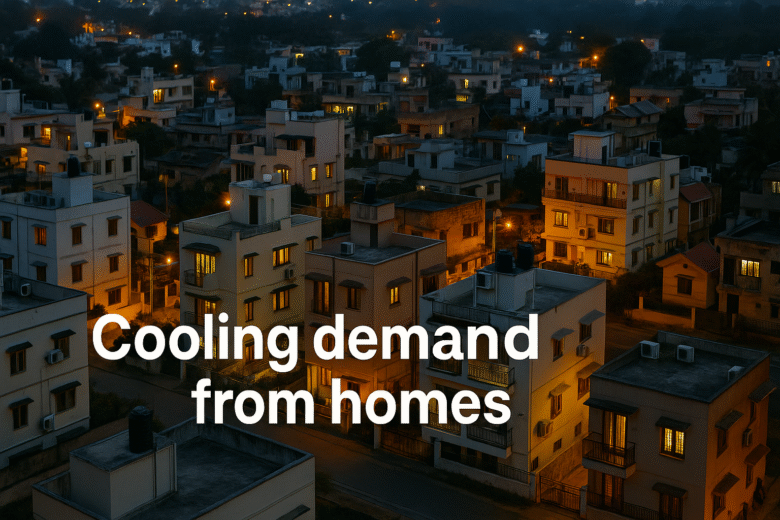Fun Fact: Globally, air-conditioning (AC) and cooling appliances use about 7% of the world’s electricity and account for roughly 3.2% of total greenhouse gas (GHG) emissions.
In India’s sweltering summers, the phrase “Cooling India’s Homes Without Climate Guilt: The Carbon Story of Air Conditioning” feels almost rebellious. Because yes, we deserve cool homes. But the carbon cost of comfort has been quietly ballooning. As more of us embrace AC units, chillers and fan-cooled rooms, the real question is: can low-carbon cooling design make the difference?
Residential Cooling: A Silent Carbon Surge
Residential cooling emissions in India have been climbing steadily. A study shows that the carbon intensity of space-cooling for Indian households rose to around 514 kg CO₂ per household by 2022, having increased by nearly 292% since 2000.
Another report warns that if AC uptake continues at current rates, India’s emissions from air-conditioning could rise by about 120 million metric tons by 2050.
What this means: every time we flip on cooling without thinking of how it’s done, we add another layer to the mountain of carbon.
Why It’s Especially Problematic in India
First, heatwaves are becoming more frequent and intense, pushing up demand for cooling.
Second, India’s grid still relies heavily on fossil-fuel powered electricity generation (~75% coal share in some analyses).
Third, many homes aren’t designed for thermal resilience in the first place—poor insulation, inadequate ventilation, and minimal shading make the AC do more heavy lifting. A piece highlighted that shading, ventilation and insulation are core passive design elements often neglected.
So, what you’ll often see: an overworked AC unit, rising bills, and higher emissions—all because the home’s built like it’s still in the 1980s.
The Promise of Low-Carbon Cooling Design
Here’s where the hope steps in. Low-carbon cooling doesn’t just mean buying the “5-star” AC unit (though that helps) — it means redesigning how we live and how our homes respond to heat. Let’s pick some examples:
Passive design features: Proper shading, cross-ventilation, thermal insulation can reduce cooling loads dramatically.
Low-GWP (global warming potential) refrigerants and higher-efficiency equipment: According to a report, shifting to low-GWP refrigerant-based technologies, radiant cooling, evaporative cooling and ground-source heat pumps could cut GHG emissions in buildings by ~35% by 2050 compared to business-as-usual.
Integrated design + renewable energy: A recent sector brief emphasises climate-responsive high-performance building design and low-energy cooling systems.
In short: the less input we need from energy-hungry machines, the lower the emissions and the lighter the guilt.

Anecdotes and Real-Life Homes
Imagine a 2BHK (2 bedroom hall kitchen) apartment in a city like Ahmedabad. The landlord decides to renovate: he installs external shades over the windows, re-aligns the orientation of rooms for cross-flow ventilation, picks an AC unit with an inverter compressor and refrigerant R-32 (lower GWP than older R-22 units), and uses a ceiling fan smartly, turning off the AC when the fan suffices. The electric meter slows, the bill drops, and the family feels cooler—not just in temperature but in conscience.
On the other side, many homes still buy the cheapest AC they can find, set it to 18°C, keep doors open, and wonder why the bill is high and they still sweat. It’s comfortable—but carbon-expensive.
Why This Matters for You, the Reader
Because your choice to cool your home doesn’t only affect your comfort—it affects the grid, the climate and the planet.
If millions of Indian households upgrade to ACs without low-carbon design, the electricity demand could outstrip predictable growth. India’s peak electricity demand has already soared with higher temperatures and AC use.
Also, India’s commitment to address cooling demand in its national framework is serious: The India Cooling Action Plan (ICAP) aims for an integrated 20-year vision of cooling demand reduction, refrigerant transition and energy-efficiency enhancement.
In other words, your home is part of the national equation—cooling it responsibly means fewer emissions, lower bills, and a cooler planet.
Conclusion: Not Just Cooler Homes—Smarter Homes
Cooling India’s homes without climate guilt isn’t about giving up comfort. It’s about getting smarter with comfort. The carbon story of air conditioning shows us the path: from heavy-use, high-carbon machines to homes that breathe, absorb less heat, use smarter tech and lean on design.
What I ask you to do: next time the heat creeps in and you consider hitting the AC on full—pause. Think: Can I shade the window? Can a fan do it fine for now? Can I raise the thermostat by a couple of degrees? Because the collective impact of small actions adds up.
If we make households part of the solution—through design, efficient tech and behaviour—we don’t just cool homes, we cool the future too.
Author’s Note
Late one night, as the fan spun and the electricity meter ticked louder than the wind outside, I wondered: what is the real cost of ‘cooling down’? So I wrote this blog. Not to preach, but to invite: invite you to think, to act, to combine comfort with conscience. And if even one home cools smarter because of this note, then the meter might move slower tomorrow—and the climate might breathe a little easier.
G.C., Ecosociosphere contributor.
References and Further Reading
- Air-conditioning in India poses risk of dramatic rise in emissions: Study
- India’s Room AC Sector – TERI (The Energy and Resources Institute) Report
- India’s Refrigerant Choice: Impact on Climate Goals and Cooling Sector
- How Energy-Efficient Cooling in India Is Cutting Emissions and Saving Lives
- Technology Landscape for Cooling: Status Update
- Low Carbon Cooling Solutions for Buildings in India – WWF India Report
- Low Energy Cooling and Ventilation for Indian Residences – Design Guide
- How Energy Demand for Cooling in India’s Cities Is Changing




